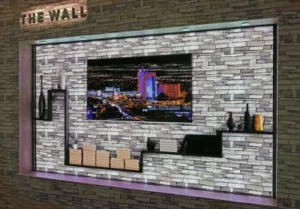CES is almost upon us, with the exhibits beginning Tuesday, January 8, and with media and analyst activities beginning Sunday, January 6.

About a year ago I strongly suggested that we analyst and media types refrain from writing any of the many CES stories before they happen. But CES is nothing if not a powerhouse publicity machine, with the Consumer Technology Association (the owner and organizer) and thousands of exhibitors and presenters mailing out tens of thousands of news releases to thousands of media, analysts, and bloggers. Many of these make their livings by writing as many articles as they can, even if the “articles” are no more than lightly edited press releases. The system rewards a surfeit of dearth.
Will I add to this sea of dearth? I will not. What I will do is talk about some display technologies and products I will be looking for — and maybe even looking at — next week.
I will be looking for the first µLED product or products. These will be near-the-eye displays or products, not relatively large displays for phones, tablets, or TVs. An exception could be the long-discussed Apple µLED watch display. Even this display exists, Apple will probably wait to introduce it at one of Apple’s own events.
At CES 2018 Samsung showed the signage and TV display it called “The Wall.” Samsung claimed The Wall was a µLED display, but the LED elements are far too large to justify that labeling. “MiniLED” is more accurate. (Photo: Samsung)
We know QDOG — quantum dots on glass, which would replace the current quantum dot enhancement film or QDEF — has been under development for several years. Will we see a QDOG TV set that will become commercially available in 2019?
A QDCF — quantum dot color filter, or QDFR for quantum dot filter replacement — has been presented by Nanosys has being the next step after QDOG. Here, instead of using a QDEF to convert the light from a blue-LED backlight, and then filtering it with a matrix color filter, the blue light is directly converted into red and green, with blue passing through, without a conventional filter at all. There have been some challenges, but Nanosys has made a case that the results would be OLED-like. Could QDCF development be catching up to QDOG, and might we see this technology in a commercially available TV in 2019?
Many of us believed that the OLED-TV burn-in problem had been solved, but a flood of evidence in 2018 made us realize that the problem remains with us and is not trivial. In testing, the problem has been serious with certain program content and far less serious with other program content. Will LG Display have a convincing demonstration that the problem is being addressed?
Samsung has announced it is working on a quantum dot OLED display for TV. The idea is somewhat like the QDCF approach described above, but the light comes from a blue OLED layer instead of an LCD sandwich, and this light is converted to green and red, with blue passing through. Since blue OLED emitters are the most problematic of the three primaries, it would seem that Samsung has some challenges ahead. Will Samsung show any prototypes?
Will we see a product or prototype that makes even a partial case that flexible display-based products make any sense? To be clear, flexible OLED displays have been used to good effect in, for instance, phones with wrap-around screens, but the phones themselves are not flexible.
Does anyone really want a phone that folds, bends, or rolls so much that they are willing to put up with the trade-offs?
Those are a few of the things I’ll be looking for next week. If I see any of them, I’ll let you know. – Ken Werner
Ken Werner is Principal of Nutmeg Consultants, specializing in the display industry, manufacturing, technology, and applications, including mobile devices, automotive, and television. He consults for attorneys, investment analysts, and companies re-positioning themselves within the display industry or using displays in their products. He is the 2017 recipient of the Society for Information Display’s Lewis and Beatrice Winner Award. You can reach him at [email protected].

